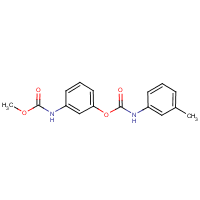Phenmedipham
Agent Name
Phenmedipham
CAS Number
13684-63-4
Formula
C16-H16-N2-O4
Major Category
Pesticides

Synonyms
3-((Methoxycarbonyl)amino)phenyl (3-methylphenyl)carbamate; 3-(Carbomethoxyamino)phenyl 3-methylcarbanilate; 3-(Methylphenyl)carbamic acid 3-((methoxycarbonyl)amino)phenyl ester; 3-Methoxycarbonyl-N-(3'-methylphenyl)-carbamat [German]; 3-Methoxycarbonylaminophenyl 3'-methylcarbanilate; 3-Methoxycarbonylaminophenyl N-3'-methylphenylcarbamate; Betanal; Carbanilic acid, m-hydroxy, methyl ester, m-methylcarbanilate (ester); EP-452; Fenmedifam; Kemifam; Methyl 3-(3-methylcarbaniloyloxy)carbanilate; Methyl 3-(m-tolylcarbamoyloxy)phenylcarbamate; Methyl N-(3-(N-(3-methylphenyl)carbamoyloxy)phenyl)carbamate; Methyl m-hydroxycarbanilate m-methylcarbanilate (ester) (8CI); Methyl m-hydroxycarbanilate, m-methylcarbanilate; Methyl-3-hydroxycarbanilate-3-methylcarbanilate; Methyl-3-m-tolycarbamoloxyphenyl carbamate; Morton EP 452; Phenmediphame [ISO-French]; S 4075; SN 4075; SN-38584; Schering 4072; Schering-38584; Spin-aid; Synbetan P; m-Hydroxycarbanilic acid methyl ester m-methylcarbanilate; Carbamic acid, (3-methylphenyl)-, 3-((methoxycarbonyl)amino)phenyl ester; [ChemIDplus]
Category
Herbicides, Other
Description
Colorless solid; [Merck Index] Colorless odorless solid; Formulated as technical solid and emulsifiable concentrate; [EPA REDs]
Sources/Uses
Used as a post-emergent herbicide; [Kanerva, p. 783] Used as a broadleaf herbicide for sugar and table beets, spinach, and Swiss chard grown for seed (over 98% used on sugar beets); [EPA REDs]
Comments
Allergic and photoallergic contact dermatitis reported in farmers; [Kanerva, p. 783] Emergency treatment: "Carbamate herbicides and fungicides"; [HSDB] The erythrocyte is the primary target of toxicity with hemolytic anemia observed in sub-chronic (rat, mouse, and dog) and chronic (rat) feeding studies; Methemoglobinemia and other hematological changes also seen in some studies; The severity of hematological effects noted in sub-chronic studies did not progress with time as evidenced in chronic studies; No developmental toxicity observed at the highest tested dose in rats (1,350 mg/kg/day) or rabbits (1,000 mg/kg/day) by gavage during gestation; [EPA REDs] May cause irritation; Toxic by skin absorption; [Aldrich MSDS]
Reference Link #1
Biomedical References
Exposure Assessment
Vapor Pressure
1E-11 mm Hg
Reference Link #2
Adverse Effects
Skin Sensitizer
Yes
Methemoglobinemia
MetHgb is secondary toxic effect
Dermatotoxin
PACD (photoallergic contact dermatitis)
Diseases, Processes, and Activities Linked to This Agent
Diseases
Occupational diseases associated with exposure to this agent:
Processes
Industrial Processes with risk of exposure: